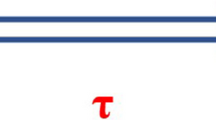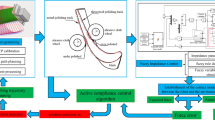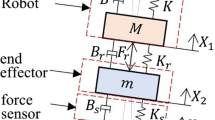Abstract
Robotic force control is crucial for precise polishing and has a significant influence on the final effects. The blade has a free-form surface in space, and the curvature changes drastically, making traditional impedance control feedback untimely. To solve this problem, this paper proposes an adaptive impedance control method for blade polishing based on Kalman filter. The force data is denoised by Kalman filtering to obtain the real force data, then the data is gravity compensated to obtain the real polishing force. The method analyzes the influences of stiffness change and displacement change on the polishing force, and establishes a stiffness and displacement coupling compensation model. The method achieves timely feedback when the robot copes with unknown environmental stiffness changes. In addition, the Lyapunov function is applied to verify the stability of the method during implementation. Four processing conditions are simulated by using Matlab Simulink. The results indicate that the proposed method can provide faster response and higher force tracking accuracy by adjusting the reference position when the environment changes. In the experiment of polishing blade, the roughness is reduced to below Ra0.32 μm and fluctuation range of polishing force is within ±1 N. The force control method performance is significantly improved and the blade surface quality is effectively improved.





































Similar content being viewed by others
Data availability
All data generated or analyzed during this study are included in this published paper.
Code availability
Not applicable.
References
Wang W, Liu F, Liu Z, Yun C (2017) Prediction of depth of cut for robotic belt grinding. Int J Adv Manuf Technol 91:699–708. https://doi.org/10.1007/s00170-016-9729-3
Wang H, Zhu D, Liu J (2019) Improving the accuracy of the blade leading/trailing edges by electrochemical machining with tangential feeding. CIRP Ann 68(1):165–168
Jin L, Zhang Y, Li S, Zhang Y (2016) Modified ZNN for time-varying quadratic programming with inherent tolerance to noises and its application to kinematic redundancy resolution of robot manipulators. IEEE Trans Ind Electron 63(11):6978–6988. https://doi.org/10.1109/TIE.2016.2590379
Zhang J, Liu J, Yang S (2022) Trajectory planning of robot-assisted abrasive cloth wheel polishing blade based on flexible contact. Int J Adv Manuf Technol 119:8211–8225. https://doi.org/10.1007/s00170-022-08737-9
Xie, Q., Zhao, H., Wang, T., & Ding, H. (2019). Adaptive impedance control for robotic polishing with an intelligent digital compliant grinder. In Intelligent Robotics and Applications: 12th International Conference, ICIRA 2019, Shenyang, China, August 8–11, 2019, Proceedings, Part VI 12 (pp. 482-494). Springer International Publishing. https://doi.org/10.1007/978-3-030-27529-7_41
Hogan, N. (1984). Impedance control: an approach to manipulation. In 1984 American Control Conference (pp. 304-313). IEEE. https://doi.org/10.23919/acc.1984.4788393
Dinh TX, Thien TD, Anh THV, Ahn KK (2018) Disturbance observer based finite time trajectory tracking control for a 3 DOF hydraulic manipulator including actuator dynamics. IEEE Access 6:36798–36809. https://doi.org/10.1109/ACCESS.2018.2848240
Xue X, Huang H, Zuo L, Wang N (2022) A compliant force control scheme for industrial robot interactive operation. Front Neurorobot 16. https://doi.org/10.3389/fnbot.2022.865187
Duan J, Gan Y, Chen M, Dai X (2019) Symmetrical adaptive variable admittance control for position/force tracking of dual-arm cooperative manipulators with unknown trajectory deviations. Robot Comput-Integr Manuf 57:357–369. https://doi.org/10.1016/j.rcim.2018.12.012
Wen S, Chen J, Qin G, Zhu Q, Wang H (2018) An improved fuzzy model predictive control algorithm based on the force/position control structure of the five-degree of freedom redundant actuation parallel robot. Int J Adv Robot Syst 15(5). https://doi.org/10.1177/1729881418804979
Tuan DM, Hieu PD (2019) Adaptive position/force control for robot manipulators using force and velocity observer. J Electr Eng Technol 14:2575–2582. https://doi.org/10.1007/s42835-019-00281-z
Zhou P, Zhou Y, Xie Q, Zhao H (2019) Adaptive force control for robotic grinding of complex blades. IOP Conference Series: Materials Science and Engineering 692(1). https://doi.org/10.1088/1757-899X/692/1/012008
Ochoa H, Cortesão R (2022) Impedance control architecture for robotic-assisted mold polishing based on human demonstration. IEEE Trans Ind Electron 69(4):3822–3830. https://doi.org/10.1109/TIE.2021.3073310
Dong J, Shi J, Liu C, Yu T (2021) Research of pneumatic polishing force control system based on high speed on/off with PWM controlling. Robot Comput Integr Manuf 70. https://doi.org/10.1016/j.rcim.2021.102133
Dong Y, Ren T, Hu K et al (2020) Contact force detection and control for robotic polishing based on joint torque sensors. Int J Adv Manuf Technol 107:2745–2756. https://doi.org/10.1007/s00170-020-05162-8
Li M, Du Z, Dong W, Gao K, Gao Y, Wu D (2022) Modeling, planning, and control of robotic grinding on free-form surface using a force-controlled belt grinding tool. Proc Inst Mech Eng C J Mech Eng Sci 236(4):2009–2028. https://doi.org/10.1177/0954406220931529
Chen F, Zhao H, Li D, Chen L, Tan C, Ding H (2019) Robotic grinding of a blisk with two degrees of freedom contact force control. Int J Adv Manuf Technol 101(1–4):461–474. https://doi.org/10.1007/s00170-018-2925-6
Zhou H, Ma S, Wang G, Deng Y, Liu Z (2021) A hybrid control strategy for grinding and polishing robot based on adaptive impedance control. Advances in Mechanical Engineering 13(3). https://doi.org/10.1177/16878140211004034
Wang Z, Zou L, Duan L, Liu X, Lv C, Gong M, Huang Y (2021) Study on passive compliance control in robotic belt grinding of nickel-based superalloy blade. J Manuf Process 68:168–179. https://doi.org/10.1016/j.jmapro.2021.07.020
Dedong T, Fengxiao L, Jingang J, Shichang S, Yang Z (2023) A review on end-effectors of robotic grinding. Recent Patents on. Engineering 17(1):e220322202521. https://doi.org/10.2174/1872212116666220322142201
Burghardt A, Szybicki D, Kurc K, Muszyńska M (2022) Robotic grinding process of turboprop engine compressor blades with active selection of contact force. Tehnički vjesnik 29(1):15–22. https://doi.org/10.17559/TV-20190710141137
Chen BH, Wang YH, Lin PC (2019) A feedback force controller fusing traditional control and reinforcement learning strategies. In: 2019 IEEE/ASME International Conference on Advanced Intelligent Mechatronics (AIM). IEEE, pp 259–265. https://doi.org/10.1109/AIM.2019.8868711
S. Chen, Z. Wang, A. Chakraborty, M. Klecka, G. Saunders and J. Wen. Robotic deep rolling with iterative learning motion and force control. IEEE Robotics and Automation Letters, vol. 5, no. 4, pp. 5581-5588, Oct. 2020, doi: https://doi.org/10.1109/LRA.2020.3009076.
Stouraitis T, Chatzinikolaidis I, Gienger M, Vijayakumar S (2020) Online hybrid motion planning for dyadic collaborative manipulation via bilevel optimization. IEEE Trans Robot 36(5):1452–1471. https://doi.org/10.1109/TRO.2020.2992987
Funding
This work was supported by the National Natural Science Foundation of China (Grant No. 52105474 and Grant No. 52375460) and The Shanxi Scholarship Council of China.
Author information
Authors and Affiliations
Contributions
The proposal and realization of this technology were mainly completed by Xuhui Zhao. Jia Liu provided machine tools and experimental conditions and participated in technical discussions. Shengqiang Yang provided guidance on research directions. Jingjing Zhang, Xufeng Lv, Long Cheng, and Xueqian Zhang participated in the research.
Corresponding authors
Ethics declarations
Conflict of interest
Jia Liu has received research support from the funding. Xuhui Zhao, Shengqiang Yang, Jingjing Zhang, Xufeng Lv, Long Cheng, and Xueqian Zhang did not get paid from the funding.
Additional information
Publisher’s Note
Springer Nature remains neutral with regard to jurisdictional claims in published maps and institutional affiliations.
Rights and permissions
Springer Nature or its licensor (e.g. a society or other partner) holds exclusive rights to this article under a publishing agreement with the author(s) or other rightsholder(s); author self-archiving of the accepted manuscript version of this article is solely governed by the terms of such publishing agreement and applicable law.
About this article
Cite this article
Zhao, X., Liu, J., Yang, S. et al. An adaptive impedance control method for blade polishing based on the Kalman filter. Int J Adv Manuf Technol 132, 1723–1739 (2024). https://doi.org/10.1007/s00170-024-13401-5
Received:
Accepted:
Published:
Issue Date:
DOI: https://doi.org/10.1007/s00170-024-13401-5




